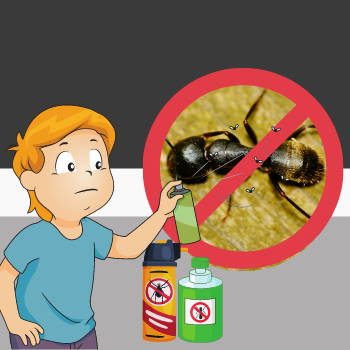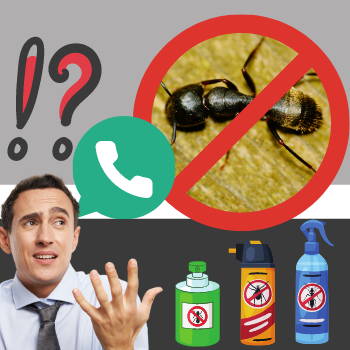Signs of Carpenter Ants in House
The worst hazard to your home is not the weather, but the huge number of rodents and bugs that live in or around your home. Carpenter ants are one of the most destructive pests out there due to the way they damage homes.
Indoor carpenter ant infestations can be found near entry points like foundations, pipes, electric wires, attic vents, telephone lines and cracks. Carpenter ants usually attack structural lumber like foam panels, hollow doors, wall voids and windows.
To control a carpenter ant infestation properly, you should call a pest control professional as soon as possible.
How to Identify Carpenter Ants
Carpenter ants prefer mouldy or wet wood. If there are moisture problems in your home, these ants will be attracted to your abode. Carpenter ants can chew their way through structural lumber.
They can also enter homes through tiny openings or cracks. They will use climb up wires and pipes or use branches to get inside your home.
Carpenter ants typically set up their nests near water sources such as sinks, bathtubs, dishwashers, and air-conditioning units. These pests can be easily identified due to their size. Carpenter ants are big – around 1/2”-5/8". They are usually all-black, red-black, all-brown, or all-red.
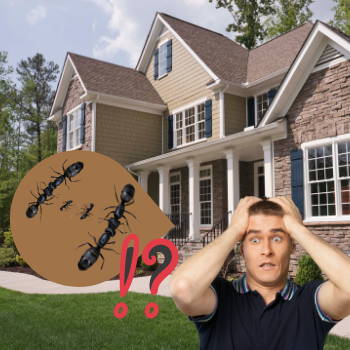
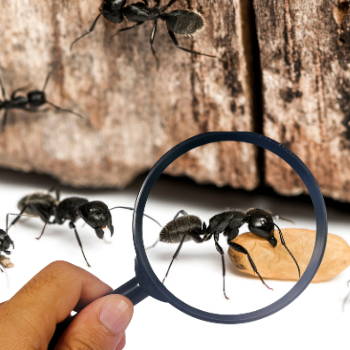
Signs of Carpenter Ants
Carpenter ants are easy to identify due to their colour and size. One of the most common signs of carpenter ants is the presence of huge black ants in your home. Carpenter ants will damage the wood they live in.
They do not eat wood for food, but they set up their nests in the softer part of the wood grain. That is why you will find piles of wood shavings near floor joists, wall studs or wooden furniture.
Here are the most common signs of carpenter ant infestations.
large red-black or black ants in or around your home
presence of large, winged ants in hidden crevices and cracks, floor joists, ceilings, and walls
sawdust or piles of wood shavings beneath wooden spots such as windowsills, door jambs and baseboards
long ant paths or ant trails in your garden. Carpenter ants travel long distances in search of food.
shed or dropped wings of swarmer or flying ants near baseboards, vents, or windowsills.
faint rustling sounds inside woodwork or in the walls. Carpenter ants are capable of burrowing into your woodwork to set up their nests. They produce rustling sounds when digging out the wood particles.
Carpenter ants will appear occasionally or sporadically. You may find several ants on one day and a few on another day, but it does not mean that they are gone.
When it is dry or sunny outside, carpenter ants may go out to look for food. However, when it is damp or cooler outside, the ants may stay in their nest to make sure that the pupae of the colony are stored well.
Carpenter ants will appear more often when the usual daily temperature starts to rise above 45⁰ F to 50⁰ F. If you saw some ants in your home, they may have been in your abode for over a year. Since wood carpenter ants usually appear at night, you may hear or see them rustling late at night or in the early morning.
If not constantly treated, the parent colony will just restock the infested area with new worker ants. Finding the main colony is not easy because carpenter ants frequently travel long distances from the parent colony to look for food.
Even if you find one main colony, it is not enough to protect your house because there might be another carpenter ant nest within range of the building.
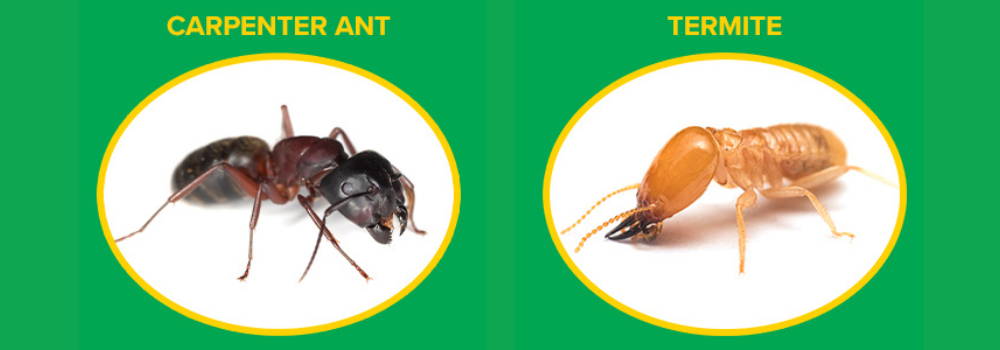
Carpenter Ant vs Termites
It is important to learn the difference between a termite infestation and carpenter ant infestation. The most obvious difference between termites and carpenter ants is that the former eat wood.
Carpenter ants, on the other hand, damage wood to set up their nests because they will not get any nutrition from wood. The best way to distinguish a termite infestation from a carpenter ant infestation is by inspecting the damaged wood or structural lumber.
Identifying Carpenter Ant Infestation from Termite Infestation
Two kinds of termites infest structural lumber – dry wood and subterranean. To differentiate subterranean termite infestations from carpenter ant infestations, you should inspect the hollowed-out wood. Subterranean termite galleries have large amounts of mud and soil, while carpenter ants polish and clean their wood galleries so that they look smooth inside.
Aside from this, carpenter ant galleries have holes where worker ants expel unwanted debris. The wood’s surface may look undamaged, but you can identify galleries of carpenter ant through these window holes.
There is also a pile of dead insects, debris, and wood shavings outside nest openings. Carpenter ants produce wood shavings that look like scraps made from sharpening pencils. The shavings have different sizes and shapes.
Dry wood termites produce debris or frass too, but the fecal pellets have the same shape and size. Carpenter ants may not cause a lot of damage at first. But if they are left alone, the number of ants inside a colony will grow and continue to damage the wood.
How to Resolve a Carpenter Ant Infestation
If you see signs of carpenter ants, you should find the nest as soon as possible. The best indicators of infestation will be the area where you found the sawdust that is produced when carpenter ants create their tunnels.
Depending on the location of the nests, you can just remove them. But if it is not possible, you can use a vacuum cleaner to remove the carpenter ants from their nest.
Afterward, discard the vacuum bag to prevent the carpenter ants from returning to your house. You also need to find and destroy satellite nests to properly resolve the carpenter ant infestation.
Here are some tips on how to prevent carpenter ants from infesting your home.
Caulk around water and electrical lines where ants could enter your home or building.
Store firewood up off the earth and away from the house.
Caulk any cracks or crevices you find to get rid of entrance paths.
Install a stone or gravel strip around the house.
Trim or cut branches near the building or house. That way, the ants will not be able to use the branches to enter your building or house.
Remove wood, logs, and stumps under or near the structure.
Clean your kitchen regularly and store food in airtight containers.
Make sure that your attic and crawl spaces are well ventilated.
Clogged gutters should be cleaned immediately to prevent moisture problems or water damage.
Fix leaks in the plumbing pipes or roof immediately.
Getting Rid of Carpenter Ants Effectively
You can also get rid of carpenter ants by eliminating scent trails. Ants use pheromone paths to travel and find food sources. By cleaning the surface where they have travelled, you can prevent them from coming back to your house. Simply wipe down the surface with a cotton ball dipped in essential oils such as orange, cedarwood, tea tree or lemon to remove these trails.
You can also mix dish soap (one part) and water (two parts) to remove these trails. Another option is to mix equal parts water and white vinegar. Transfer the solution into a spray bottle and spray the trails with the solution.
The solutions can be used to kill ants as well. The best thing about the solutions is that you can make them anytime. Moreover, the solutions will not harm your pets. The ingredients for the solutions are easy to find as well.
Products we recommend are the following:
When to Call a Pest Control Professional
If you suspect that your home is infested with carpenter ants, call a pest management professional right away. This is particularly important if you cannot find the nest.
The pest control company will perform a thorough inspection of your property to find the nest or at least a possible nest site before treatment. Finding the nest(s) is not easy, so you need to be patient.
The pest management professional will regularly treat the building’s exterior perimeter to protect it from ants or to control nests. The treatment process can be extremely effective if all nests are found.
Void insecticide injections and residual insecticides are pest control options used to treat carpenter ant infestations. This process usually requires occupants to vacate the house or building for a certain period.
